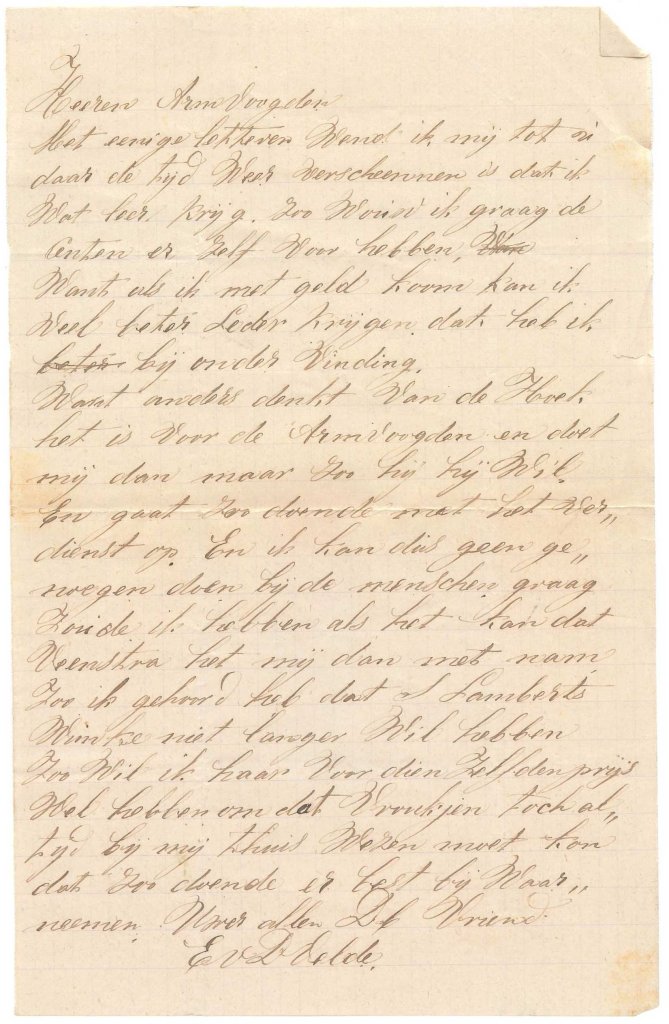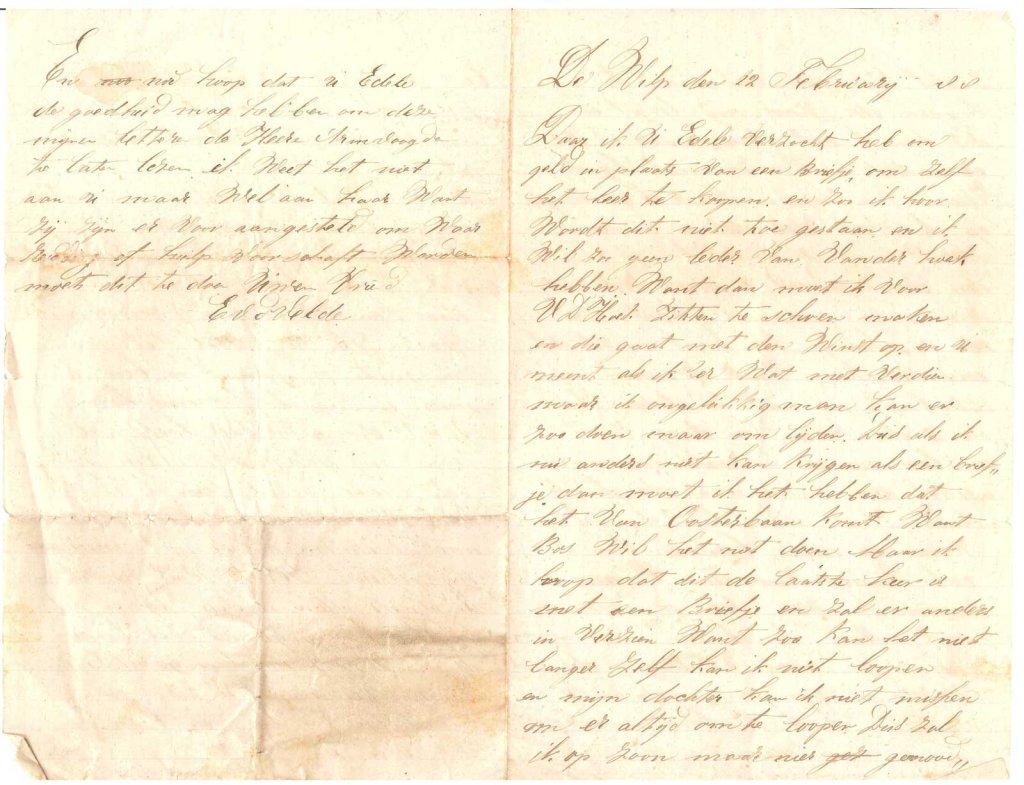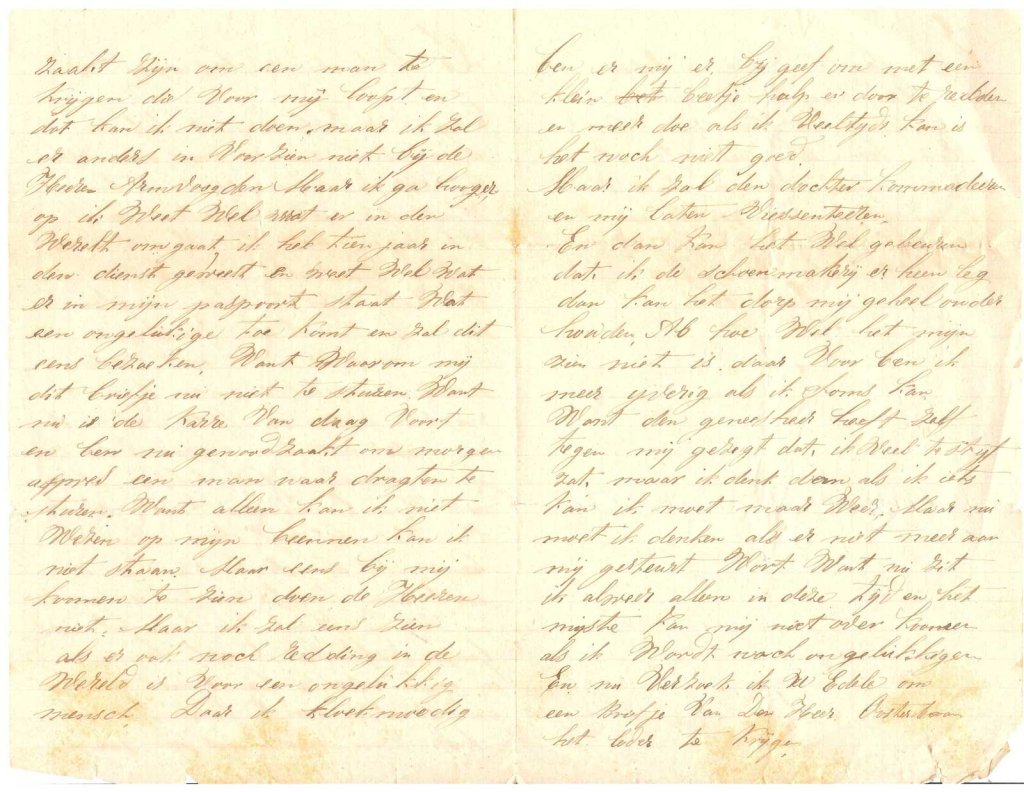
1888: Poor relief in Opsterland
This time it is about the care of the poor in Opsterland and we get an insight into the difficult living conditions of an invalid worker from the last quarter of the nineteenth century. In the late 1880s, the economic crisis in the Netherlands (and the world) is at an all-time low. Moreover, peat extraction in Southeast Friesland was then nearing its end. In 1888 and 1890 large peat strikes took place, in the latter year among others at Nij Beets with a speech by Domela Nieuwenhuis. There was great poverty and thus more demand for help from the population to remain self-reliant.

Legislation and organization surrounding poor care
In 1854, the Law regulating the poor board came into effect. This regulated that the focus of poor care was to be the churches. Many churches operated orphanages and hospices. Poorhouses, also called diaconate houses, were used to provide shelter for people who could not care for themselves. Poor care at that time meant literally caring for the poor through begging; it was not about fighting poverty. Municipalities usually had only a supplementary role.
A poorhouse often consisted of small rooms, sometimes housing an entire family. Several villages in Opsterland had such poorhouses. These could be found, among others, in Beetsterzwaag (Kerkepad Oost 18 and at Hoofdstraat 79, the latter built in the early nineteenth century and discontinued in 1928), Terwispel (De Streek 79), Ureterp (at De Feart), Langezwaag and Gorredijk. In 1825, the Jewish Church Council purchased for 250 guilders a newly built building in Gorredijk located on the road on Trimbeets under Terwispel, opposite the spot where later the military barracks would be built. This building was intended for needy families. The poorhouse in Ureterp took in poor people from all over the community. Some poorhouses focused only on elderly single ladies or orphans.

Changing roles: churches, congregation and individuals
Until 1898, each village in Opsterland had its own separate poor guardianship (filled with volunteers). In the course of time, the municipality also received more responsibilities. From 1890 there was a general poor board for all of Opsterland. From this time on there were three departments, which fell under the general poor board. The system of the poor guardianship can be seen as a forerunner of what we now know as the social service/WMO.
Associations in Opsterland involved in the care of the poor included the Vereeniging "Door Arbeid tot verbetering", Afdeeling Gorredijk (founded 1895), the Algemene Armvoogdij-administratie, which from January 1, 1866, took over Health for the Jewish poor, and the Jongedochters-Vereeniging der Gereformeerde Kerk in Lippenhuizen (founded 1899). Private initiatives with the aim of improving living conditions, such as the Werkverschaffing, are also known from benefactor P.W. Janssen, among others. In Opsterland the following work relief projects were carried out, among others: a project southeast of Nij Beets, "Arbeid Adelt" southwest of Terwispel, "De Lange en Korte Ripen" and project "Onder Wijnjeterp" of the Drie Provinciën. Other agencies that were active in poor care in Opsterland municipality included the Cornelia Foundation (founded in 1915) and the Van Teyens Fundatie (founded in 1858).
Changing view of poor care: only for the truly needy
Developments at the time, such as industrialization and the creation of more jobs, changed the view of poor care. In 1870, the Poor Law was amended: the poor who could work were no longer allowed to use begging or work relief. Its charitable portion after 1870 had to benefit those who were truly needy, such as invalids, the sick, orphans, the elderly and single mothers. Others had to earn their own living. The support given generally consisted of clothing, food and medicine, not money. And that was precisely what was still sometimes difficult for some, according to Ebbel van der Velde's request for help and correspondence in some letters.


Shoemaker Ebbel van der Velde's request for help
Ebbel van der Velde was born on May 9, 1831 in Marum. Ebbel was a shoemaker (also called a laborer). He had already experienced several misfortunes in his life. In 1872, his 1-year-old daughter had died. His wife Roelfke Randel, laborer by profession, died on September 23, 1884 in Siegerswoude. She was then 42 years old. In 1889 his daughter Frouke married Benne Linting from Marum, who came to live with Ebbel together until 1892.
Ebbel could not make enough money with his work. Therefore, in 1888 he applied for support from the poor guardianship of Siegerswoude and eventually he also sought the help of the mayor of Opsterland. Ebbel was an invalid, unable to stand on his feet and received support. He would also like to receive money so that he could buy leather for his shoemaking business. From his text it shines through, that he certainly wants to work to continue his work, but is thwarted in this way. And that it might then be better for him to give up his work altogether, then the village could take care of all of Health for him. Still, the poor guardianship rejects his request again, so he asks the mayor for help. This one certainly cares about his fate: Ebbel would be one of the first designated people to earn help, given his hardship. It may be that the local poor guardianship still tried to divert Ebbel to Marum, where he was born. This was common in those days. Ebbel died on November 19, 1893 in Siegerswoude. He was 63 years old at the time.
Image gallery




